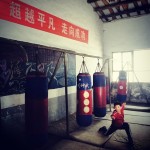MMA
Category
-
Cyborg on Female Fighters
-
UFC Fighter Donald Cerrone on Fear
-
Community Power and Cage Power
I wrote a story on the fly that in and of itself is a bit short and shallow, but might point at a very interesting aspect of martial arts in China. The story, “Making the List: Traditional Martial Arts and Community Power,” came about as many of my posts do, during a conversation with Ben Judkins of Kungfu Tea. The idea is basically that Chinese martial artists are more interested in the power of community through recognition (often from the authorities) than in the power of heroic glory through hand to hand combat.
And really this should make a lot of sense to anyone who takes a step back to look at it. If a community is codified, and has its stories and legends enshrined as “history” as opposed to “myth,” then longevity and survival into the future are pretty much assured. To destroy a culture, you must first burn their books. To create a culture, you must first write your story and have it read. Once a martial art is recognized as a community, it becomes something so much more than the masters or students who developed the style and for the masters today in China who see their arts withering before their eyes, nothing is more precious than “making the list.”
In my mind I picture an ark leaving port. Martial arts right now seem to be an ark on the move, with mixed martial arts driving a need for all styles to prove themselves in some way or be left behind. In the West, this discussion revolves around efficacy in one-on-one combat, but in the East that is not necessarily the case.
This is one aspect of the disconnect between modern mixed martial arts’ rise in popularity and the slow demise of traditional martial arts—which I honestly am less inclined to subscribe to when the world is taken into account, and not just Mainland China. But that is a different discussion … the point I am trying to understand is this:
If we measure the strength of traditional martial arts by the number of combatants we can name active in the many MMA etc promotion, then things seem dismal. But if we change the metric to the strength of a community, to the power of the myths, to the enduring nature of “kung fu” the brand and symbol of a certain culture, are things still as dismal?
-
Reading: The Shaolin Monastery and Thrown
I sent for “The Shaolin Monastery” and “Thrown” a couple of weeks ago and have already made it to the end of the former. I wrote a small essay for Fightland that basically elaborates slightly on the first few chapters of Meir Shahar’s work on the Shaolin Monastery, and I might squeeze out another article on the transition from staff to fist. I found that to be pretty interesting, the fact that the staff came from the lore of proto-Buddhism, became the weapon of choice for the fighting monk, but then sometime around the Ming dynasty gave way to fists and hand to hand combat techniques.
It shouldn’t be surprising really. From the Yuan to the Qing there is a “civilizing” wave that swept through China (and the world?) that transformed the hard, short, and brutal lives of medieval people into the stratified, maybe even fulfilling lives of the pre-modern eras. The literary record changes, the types of writings we see change, and the topics people wrote of changed. Did the Mongols have anything to do with it? Or was it just a continuance of the Song dynasty’s regal splendor, broken up for a century by interlopers? I don’t know … just musing.
Also Meir Shahar needs to be commended for pulling so much out of the Chinese sources he has. I read through some of them and it requires a incredible amount of cross referencing and lateral studies to understand what exactly is being discussed. The Chinese seem to enjoy vagaries when being scholarly. It’s as if the old historians can’t suppress those original dreams of being a wandering poet-warrior-minstrel. Instead, they record the wanderings and exploits of others and add as much poetry as they can. I guess any classical/medieval/pre-modern writing will seem so old to young eyes. I for one find classical Greek descriptions of minor king and Song era musings on temples and peaks and the clouds to be absolutely entrancing.
I have looked into the classical curriculum here at the University of Minnesota.
********
As for Thrown, it hits much closer to home. Kerry Howley shadowed two fighters while she was at the University of Iowa’s famed Creative Writing program, and pretty much dropped the mic on the MMA story for now. It was never my intention to write a book like Kerry’s, in the sense of following around MMA fighters and recording their actions while placing them into a heady phenomenological framework, but then again it kinds was, except I trade Iowa for Sichuan and MMA for kung fu.
It will be hard at first, to read something written as I feel I might be able to write, but then again it reminds me of stretching. It hurts at first, but as soon as you get into the right breathing sequence, it’s positively divine. I expect to learn so much from her book, be inspired by her findings, and be able to find new and interesting nooks in my own experience and readings as I flip through hers.
I do not, however, expect people to muse out loud about whether or not I slept with my subjects.
-
The New Masters Documentary on the BBC
Director Chris Cherry was on the BBC recently discussing MMA in China, the documentary we are working on, and the routes out of poverty for poor fighters. Check out the video and full audio interview below.




